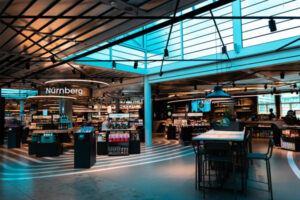By Klaus Striebich
Digitalization is undoubtedly the start of another wave of innovation, as was previously the case in retail, for example, with the emergence of new sales formats or the introduction of self-service. It has changed all of our lives and will continue to do so – whether we like it or not.
Innovations or even disruptions in retail have always had the purpose and goal of making buying and selling easier, more attractive, and better – of generating demand and fulfilling the needs and desires that arise as a result. Prior to that, however, the simplification and optimization of retail processes, the reduction of goods procurement costs, and profit optimization were the top priorities. We, the customers, then immediately followed in second place.
24/7 – Anything / Anywhere / Anytime
However, a very significant change in this new “age of digitalization” can be found in the fact that, with the information transparency that has arisen and the possibility of basically being able to obtain all goods and services in any quantity, at the most favorable prices and whenever, we, as customers, have finally become (or are becoming) the focal point of everything that is done. The catchphrase “24/7 – Anything / Anywhere / Anytime” illustrates the infinite possibilities that have arisen in such a short period of time and with such intense complexity.
The opportunities presented by digitalization, given all its technical sophistication, countless apps, social media channels, and connections with respect to the “IoT – Internet of Things”, seem limitless, and everything has seemingly been made possible. How convenient is being able to gather information online in the middle of the night via your smartphone, receive personalized offers and price suggestions, and then pick items up the following morning at the nearest store – all while enjoying a cup of coffee as a staff member kindly explains how to use the product you have ordered? As humans, we customers strive for comfort, simplicity, and the most straightforward processes possible. Those are some of the basic needs that have been deeply rooted in our genes for thousands of years, even if we prefer not to say so out loud.
However, what is the reality of our digital age really like? Are the login processes, online registrations, and necessary linking of various hardware and software and their usability in the context of the digital “multi-channel journey” really that simple and convenient? Is it not all too common for people to get lost in the depths of various IT systems or to give up in frustration? When using digital devices, you often have the feeling that the goods on the shelf are placed at a height of 2.5 meters, yet you are only 1.7 meters tall.
Waiting for Deliveries
Do you tick all the boxes in the forms correctly, and can you remember your own 10-character password, including numbers and special characters (which you are expected to change on a regular basis)? All of that is in addition to the necessary e-mails required for password confirmations, the sending of SMS codes, and the more or less satisfactory readability of homepages on various devices.

Human beings have yet another need: As soon as we are aware of a product or service and feel the desire to use it, we want to have it. And, we want it immediately. We certainly do not want to have to wait until the delivery man rings the doorbell – assuming he does not simply drop a notification card in the mailbox for the following day.
At a brick-and-mortar store, I can decide to buy goods and take them home immediately. That is an unbeatable advantage – except, of course, for the wait at the checkout. The combination of digital payment methods and the easy recognition of the shopping basket, in other words, the items to be purchased, with the necessity of the in-store checkout and control process, provides a level playing field. Should you complete your online shopping with one click or simply walk out of a store with your shopping basket, secure in the knowledge that everything will be handled automatically? Indeed, there are reasons for the success and enormous growth of Amazon, which, through the use of such near-perfect methods, has placed pure customer orientation at the center of its work, thereby setting the standard – that is, until someone else comes along and does things even better.
In Search of the “Shoppers’ Paradise”
These days, retailers are tasked with more than “just” procuring goods, customizing them somewhat, and making them accessible to customers. The so-called “Shoppers’ Paradise” is no longer considered a utopia. If there are any limitations for retailers and customers that exist, they exist solely in our minds. The expectations that customers have of retailers will continue to rise significantly. In addition to the availability of the goods themselves, the experience of the purchasing process and personalized service will become even more important. Managing and, more importantly, meeting those expectations has become the biggest challenge.
Any useful innovation in that regard will surely prove to be helpful. However, let us endeavor to ensure that such innovations do not merely serve an end in themselves, but that they are exclusively designed to make customers’ lives just a bit more comfortable, more convenient, more enjoyable, better, and more satisfying. It could be as simple as that.






